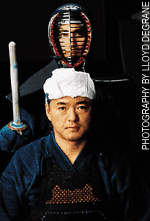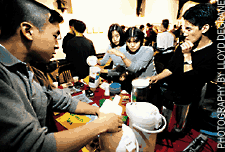 Even
though it's Friday at 5 p.m., Classics Room 10 remains bustling.
Tonight, April 7, is the opening event of PanAsia, a series
of lectures, performances, panels, and culinary experiences
designed to educate everyone on campus, Asian heritage or no,
about the vast diversity of Asian and Asian-American cultures.
This evening features Korean-American drum troupe Loose Roots
and tables full of savory and spicy Korean, Filipino, and Chinese
food.
Even
though it's Friday at 5 p.m., Classics Room 10 remains bustling.
Tonight, April 7, is the opening event of PanAsia, a series
of lectures, performances, panels, and culinary experiences
designed to educate everyone on campus, Asian heritage or no,
about the vast diversity of Asian and Asian-American cultures.
This evening features Korean-American drum troupe Loose Roots
and tables full of savory and spicy Korean, Filipino, and Chinese
food.
 |
| Kendo
instructors Erick
Huang, AB'96, with helmet, and Hyonggun Choi, a Regenstein
librarian, prepare to face off. |
History
professor James E. Ketelaar, AM'82, PhD'87, speaks first. The
director of the Center for East Asian Studies, he notes the
U of C's long history of scholarship on East Asia--but also
a lack of contact among Asian student groups at the University.
That disconnect, he explains, prompted him to suggest to some
of his students the idea for PanAsia, based on a similar project
at Stanford.
One of
those students is PanAsia chair Jay Monteverde. A fourth-year
whose ethnicity is Chinese but whose parents were born and raised
in the Philippines (he himself was born and raised in Chicago),
Monteverde introduces Loose Roots, which he says will be playing
Korean celebratory music--in American terms, "old-school block
party music." Besides playing in the group, he also serves as
its bu-soe, or second leader. Wearing soft white trousers and
tunics, blue vests, and red or yellow sashes, Monteverde and
four other players take seats on the floor next to Julian Berke,
a Caucasian third-year who is the group's leader, or sang-soe.
After 15 minutes of glorious thunder from drums and gongs, the
music ends abruptly to much applause.
"Everybody,
let's eat!" Monteverde urges. If there is a truism of campus
life, it is this: Free food draws a crowd. Tonight, about 70
people queue for Korean japchae and hot squid, Filipino pansit,
and Chinese dumplings, fried rice, lo mein, and cashew chicken.
Exhausted
by the performance, Monteverde takes a moment to wipe his brow
and to explain why, in a senior year full of exams, and soul-searching
about his future, he's devoted several months to the event:
"PanAsia is so big you can't ignore it." He has a story to tell,
about a friend who heard some "Caucasian jocks," U of C students,
walk by the Asian Students Union film festival a year ago and
dismiss it as "just another Asian event." Monteverde wants to
make clear that the University community not only can't ignore
the event called PanAsia, but also can't ignore the ever-growing
number of students who are Pan-Asian.
 |
| Karen
Kim, of
Loose Roots, takes a
breather. |
As recently
as 1980, Asian students made up just 6.4 percent of the undergraduate
student body, a number that grew to 15.35 percent in 1990. These
days, according to autumn 1999 enrollment statistics from the
University registrar, the undergraduate student body is 20.63
percent Asian-American, about 808 students. Nationwide, the
U.S. Census Bureau estimates that as of March 1, Asians and
Pacific Islanders made up just 4 percent of the population.
While this clearly makes those groups minorities in the U.S.
as a whole, the situation on campus is a bit different. The
U of C's Coordinating Council on Minority Issues focuses most
of its efforts on African-American, Hispanic, and Latin-American
students. Among Asian-American students, there are differing
views on whether they are minorities in a sense beyond the statistical.
"Part of
the reason Asians are not really considered a minority on campus
is because we are pretty visually prominent," says Monteverde.
"But the fact is we are still a minority, and face similar minority
issues such as racism, prejudice, and poverty." He cites white
supremacist Benjamin Smith's 1999 rampage through Illinois and
Indiana, in which Smith shot at Orthodox Jews, Asians, and African
Americans, killing a Korean man and an African-American man.
Less tragic but still disturbing, Monteverde says that on campus
he has heard both racial epithets directed at Asians and stereotypical
remarks about Asians.
Student
Government President Andrew Hong has a different perspective.
Though his ethnic background is Taiwanese, he considers himself
"more American than Asian-American if I had to choose." Whereas
Monteverde credits faculty and fellow students at the U of C
with helping him to "connect with an ancestry halfway around
the world," Hong says that when he arrived at Chicago, "some
of that need to associate with Asian/Asian-American culture
disappeared." He doesn't really see Asian or Asian-American
students as a minority on campus, adding, "What makes the U
of C so great is that any student can rise to the top no matter
what."
Despite
the wide range of opinions on what it means and how it feels
to be Asian, Asian-American, or American--even whether to take
pride in those identifiers or to see them as labels--students
agree that you can't lump all things--and people--Asian into
one group. Says Monteverde, "There is as much diversity and
sometimes conflict in the Asian-American community as there
is in America itself."
 |
| Visitors
to the PanAsian Teahouse sample
a variety of treats. |
Highlighting
Asian-American culture, politics, and expression, PanAsia was
designed to be accessible yet rich in information about the
history and struggles of Asian peoples in Asia and in the United
States. It also provided students with a place to share their
own thoughts and feelings--and to have some fun.
The program,
which stretched over nine days and included more than a score
of events, required the efforts of some 15 Asian-related student
groups, led by a coordinating committee of Monteverde, events
coordinator Marissa Graciosa, and financial chair Rolando Capinpin.
Each participating recognized student organization contributed
ideas and time, with most of the funding coming from the Center
for East Asian Studies, Student Government, and a quartet of
dot-coms: Indogrocer.com, Namaste.com, Bigwords.com, and Asianavenue.com.
The best-attended PanAsia events drew audiences of 200-plus.
"I believe we accomplished our main goal, which was to present,
teach, and share the various Asian cultures without resorting
to stereotypes," says Capinpin, a fourth-year who has participated
in campus Chinese, Korean, and Japanese clubs, as well as Samahan,
the Filipino group that represents his own ethnicity. "There
was a good mix of Asian and non-Asian at many of the events."

![]()
 Even
though it's Friday at 5 p.m., Classics Room 10 remains bustling.
Tonight, April 7, is the opening event of PanAsia, a series
of lectures, performances, panels, and culinary experiences
designed to educate everyone on campus, Asian heritage or no,
about the vast diversity of Asian and Asian-American cultures.
This evening features Korean-American drum troupe Loose Roots
and tables full of savory and spicy Korean, Filipino, and Chinese
food.
Even
though it's Friday at 5 p.m., Classics Room 10 remains bustling.
Tonight, April 7, is the opening event of PanAsia, a series
of lectures, performances, panels, and culinary experiences
designed to educate everyone on campus, Asian heritage or no,
about the vast diversity of Asian and Asian-American cultures.
This evening features Korean-American drum troupe Loose Roots
and tables full of savory and spicy Korean, Filipino, and Chinese
food. 

